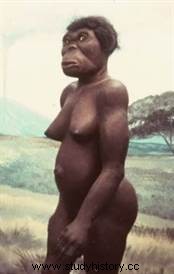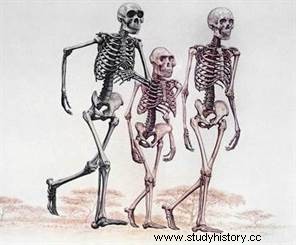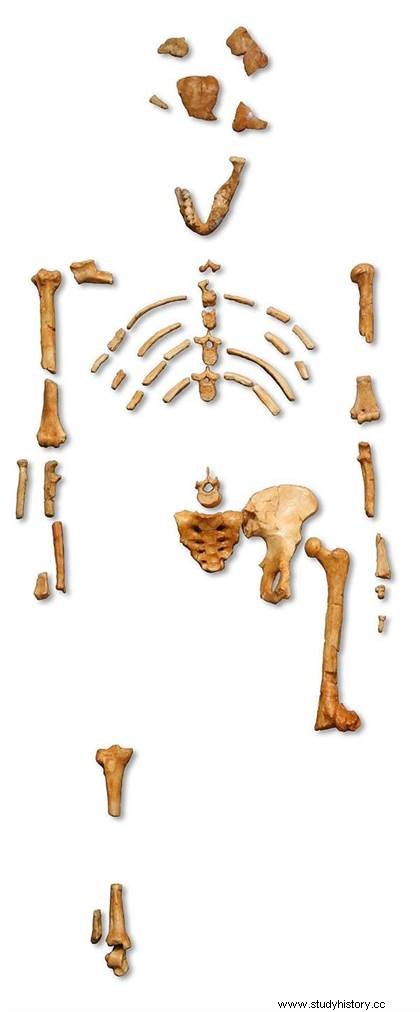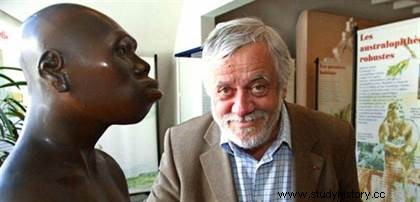 The Discovery of Lucy in 1974 in Ethiopia marked the spirits because of the state of conservation of its skeleton and its age, 3.2 million years. Composed of 52 bone fragments, study of Lucy's skeleton will reveal that she walked on two legs. This modern human ancestor of the Australopithecus afarensis species would become a planetary celebrity that would not be overshadowed by subsequent discoveries of other fossils.
The Discovery of Lucy in 1974 in Ethiopia marked the spirits because of the state of conservation of its skeleton and its age, 3.2 million years. Composed of 52 bone fragments, study of Lucy's skeleton will reveal that she walked on two legs. This modern human ancestor of the Australopithecus afarensis species would become a planetary celebrity that would not be overshadowed by subsequent discoveries of other fossils.
Far in prehistory, the origins of man
According to the most widespread theory of evolution, the human species was born more than 5 million years ago, during the Miocene era (25 million to 5 million years BC). The Earth's climate was then much warmer and wetter than it is today, so much so that rainforest covered most of Africa, Europe and Asia. It was home to many species of primates, including our ancestor.
 Towards the end of the Miocene, the Earth's temperature cooled, the climate became drier and ice caps formed at the poles. The forest withered, giving way to vast wooded and grassy areas. In East Africa, the first hominids (family of primates including Homo sapiens and its immediate ancestors) saw their natural habitat shrink. Previously, they lived in trees and moved on their four limbs. In order to cross the wide open spaces quickly and safely, some began to walk on two legs, thus inaugurating our mode of travel.
Towards the end of the Miocene, the Earth's temperature cooled, the climate became drier and ice caps formed at the poles. The forest withered, giving way to vast wooded and grassy areas. In East Africa, the first hominids (family of primates including Homo sapiens and its immediate ancestors) saw their natural habitat shrink. Previously, they lived in trees and moved on their four limbs. In order to cross the wide open spaces quickly and safely, some began to walk on two legs, thus inaugurating our mode of travel.
This evolution took place over several million years. The discovery of human fossils has allowed us to identify our most distant ancestors. The oldest known to date; Ardepithecus ramidus, lived 4.4 million years ago, probably still in forests and at the top of trees, like chimpanzees. It is not known if he was standing. There is evidence that Australopithecus afarensis, a later hominid, since it appeared about 3.5 million years ago, was bipedal.
Australopithecus, objective of an international expedition
 In 1972, an expedition of around thirty French, American and Ethiopian researchers set up. Research in southern and eastern Africa allowing the updating of Australopithecus remains being more and more fruitful, the paleontologist Yves Coppens, the geologist Maurice Taïeb and the American paleoanthropologist Donald Johanson, settled on the site of Hadar, located in the northwest of Ethiopia, on the banks of the Awash River.
In 1972, an expedition of around thirty French, American and Ethiopian researchers set up. Research in southern and eastern Africa allowing the updating of Australopithecus remains being more and more fruitful, the paleontologist Yves Coppens, the geologist Maurice Taïeb and the American paleoanthropologist Donald Johanson, settled on the site of Hadar, located in the northwest of Ethiopia, on the banks of the Awash River.
It was after long months of research that an assistant to Donald Johanson, Tom Gray, a paleontology student, discovered on November 30, 1974, the skeleton of the woman who will revolutionize our perception of human origins and, thereby, become a superstar.
Indeed, this new Australopithecus (Australopithecus afarensis ), which emerged from the dawn of time, is exceptional in its state of preservation. With fifty-two bones, 40% of its skeleton is complete. As such, along with certain Australopithecus africanus from Sterkfontein Cave in South Africa, he became one of the most complete hominids known to date back more than 3 million years.
Lucy's discovery
This female skeleton, listed as AL 288, is named Lucy in reference to the Beatles and their song Lucy in the Sky with Diamonds that the members of the expedition listen to in the evening while marking the day's discoveries. This is followed by complex dating work which, thanks to the identification of a reliable volcanic marker located a little below the sediments which contained the fossil, reveals its age:3.2 million years.
 She is a female, about 20 years old, measuring just over a meter and weighing little nearly 25 kg. Its cranial capacity is 400 cm3. The researchers assume that she died drowned as indicated by her position and the nature of the sediments in which she was found. A more recent hypothesis suggests that she died falling from a tree
She is a female, about 20 years old, measuring just over a meter and weighing little nearly 25 kg. Its cranial capacity is 400 cm3. The researchers assume that she died drowned as indicated by her position and the nature of the sediments in which she was found. A more recent hypothesis suggests that she died falling from a tree
On the other hand, the detailed anatomical study of Lucy shows that she still lived in the trees much of her time, although on the ground, in the savannah raised, it was bipedal. Its postcranial skeleton indeed presents a combination of characters which betray both a bipedal mode of locomotion - in view of the bearing of its head, the curvature of its vertebral column, the shape of its pelvis and its femur - and a aptitude for arboreal life - as evidenced by his shoulder and elbow joints as well as his long arms and short legs.
It belongs to a species that evolved over several hundred thousand years in East Africa, from present-day Ethiopia to Tanzania, passing through Kenya . Lucy will be considered for many years to belong to the oldest species in the human line. It will then be interpreted as a species close to the genus Homo.
After Lucy
Since Lucy's discovery, the Orrorin tugenensis , a 6 million year old fossil, was unearthed in Kenya; in Ethiopia, researchers have also discovered ardipithecus kadabba 5.7 million years old. Finally, in 2001, the Sahelanthropus tchadensis , baptized “Tournaï” (“hope of life”), 7 million years old, was found in Chad. But he is the subject of significant controversy because of his characters both human and simian. Man or gorilla? Researchers are divided. As for Lucy, she rests in the National Museum of Ethiopia, in Addis Ababa, the capital of the country.
To go further
- Lucy's Dream, by Yves Coppens. Points, June 1997.
- The odyssey of the species, docu-fiction. DVD, France TV, 2017.
- Australopithecines. Collective work, Artcom, 2017.

